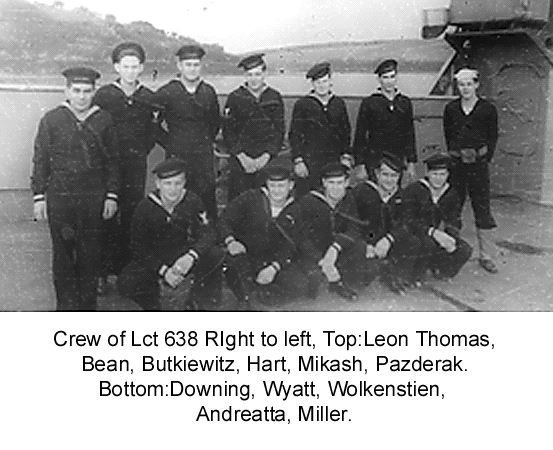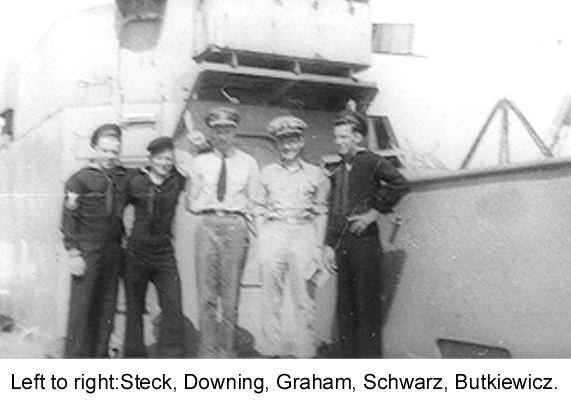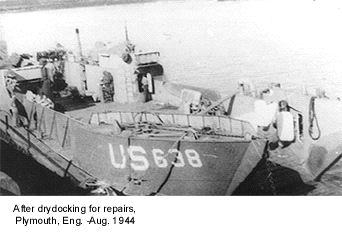Dartmouth,
England the 638 lost the Escort vessel in a dense fog and ran aground about
7 miles south of Dover. The British said that the 638 had come through their
shore defenses and the crew went ashore until a British Minelayer came in at
high tide and towed the 638 to Dover where it was put into drydock for
repairs.
When repairs were completed the 638 proceeded to Dartmouth, England to
join LCT Flotilla 19 which was based in Dartmouth under the command of Lt.
Cmdr. L. B. Pruitt arriving on April 30, 1944.
On May 2, 1944 Ens. Joseph D. Graham was assigned as O-in-C of the 638
and Ens. Eugene Schwartz was designated as Relief Officer. We received
orders to sail for Plymouth but were unable to raise the anchor due to a
malfunction of the anchor wench but sailed the next day, unloaded the LCM
that had been on the deck and returned to Dartmouth on May 9. From then
until May 16 needed repairs and alterations were made. On May 16 received
orders to sail to Plymouth for loading for the Invasion. At Plymouth we were
loaded with 180 tons of ammunition, mostly crated, varying from small arms
to large bombs for aircraft. Also took on provisions, fresh water and diesel
fuel. Large lettered signs with the word "AMMUNITION" were placed
on both sides of the vessel.
On May 27 we sailed for Portland but put into Dartmouth for the night due
to bad weather. Continued on to Portland next day. The Germans had dropped
floating mines here the night before with some damage and did so again
tonight with less damage.
On May 29 we loaded more rations and fresh water and were briefed on our
part in the invasion. On June 2 we beached and took on an Army truck loaded
with small arms ammunition and two Army Personnel. The truck was placed in
the bow where room had been left for it in front of the boxed Ammunition.
On June 3 we had our final briefing for the Invasion.
On June 4 we set sail for the Normandy Coast at 0400 hours along with
the entire Invasion Fleet and at 0800 hours were turned back due to a
delay ordered by Gen. Eisenhower. At 0400 on June 5 set sail again for the
Invasion sailing all day and all night in convoy with the entire LCT
Flotilla 19 and on June 6 were eight miles off the French Coast at 0600
hours. We were too far out to see much of what was going on but the Invasion
of Europe begins.
Officers and crew alike did not know what to expect but all were alert
and watchful. Ensign C. E. Lilly (who was later to become O-in-C of the 638
but was O-in-C of the LCT 637 on the invasion date) described that morning
about as well as any description I have heard in a story he wrote for his
children about his war experiences and I quote.. "During the day as we
waited our turn to beach we were orbiting offshore fairly close in and under
sporadic fire from shore. From that perspective, everything seemed to me to
have an unreal quality. From where we were there was none of the sound or
fury that characterize the Hollywood war movie. Everything outside the arena
of battle was curiously peaceful. The sky was blue with scattered clouds,
just like any normal day. Gulls circled around seemingly undisturbed. Ashore
we could see farm houses and cattle grazing - everything seemed to be in
order. Yet in front of us, on the beach were explosions, fires, the crackle
of guns. Close inspection with glasses turned up bodies of dead and
wounded."
Per the invasion plans the LCT 638 a unit of Force 0-1 left the line of
departure headed for Easy Red Beach at H-hour plus 1 through supposedly mine
swept waters. About 3000 yards off the beach we were stopped by the
Beachmaster Control Craft and told to lay to until further orders because
the beach was not secure enough. They said if we went in and got hit we
would blow up the whole beach and everything on it so we laid to awaiting
further orders.
With field glasses we can see some of the action on the beach. It appears
that the Germans have the beach in a crossfire with their 88mm guns in
concrete bunkers and are knocking off most everything on the beach but not
firing at anything far offshore so we feel fairly safe staying where we are.
The Army Lt. and some of the crew feel that we should go a little farther
out but the Skipper opted to stay put for a while in case we are needed but
when a shell exploded a couple of hundred yards off our port side he decided
to lay to farther out. With field glasses we can see various types of
landing craft afire and apparently abandoned on the beach. A Destroyer is
giving the Jerrys hell in their bunkers. Every time the 88s let go at
something on the beach that tin can lets go a salvo at the bunkers. Then the
88s are quiet for a while. The destroyer must have been grounded for a time
as she stayed in close to the beach and should be credited with holding the
beach that day.
Towards evening we were given orders to anchor about three miles offshore
for the night and away from the rest of the fleet so that if we got hit in
an air raid we would not be a danger to other ships.
About 2300 hours the Jerrys came over and were met with the most
tremendous anti-aircraft barrage imaginable. We did not use our 20mm guns so
as not to draw the attention of the attackers. Being so far away from the
rest of the fleet left us pretty vulnerable to air attack. No one could see
the planes and they were just throwing up ammunition hoping to hit a plane
in the dark. Several of our own barrage balloons were shot down and at first
we thought they were planes shot down but when a plane was shot down we knew
what it was.
We were anchored with our bow towards shore and when the plane hit the
water about 100 yards off our stern it was traveling in a line parallel to
the beach and was on fire. The pilot had bailed out and landed within about
25 yards of our starboard side. The wind blew the gasoline fire towards our
stern and as we were starting our engines to try to avoid them it changed
direction and the fire drifted off our port side. The waters were too choppy
for our little dinghy and it was too risky to attempt a rescue. Shortly
someone in an LCM appeared and killed the pilot with a Thompson submachine
gun.
Sleep came in short naps during the night after witnessing the greatest
invasion in history and all of its death and destruction that day.
On June 7 we beached at our designated landing area at 1000 hours but the
beach is still too hot and we are ordered to retract as soon as the army
truck and personnel are unloaded. There is still occasional sniper fire and
we keep our heads below deck or inside the control house. The beach is
littered with dead bodies, abandoned equipment and wrecked craft.
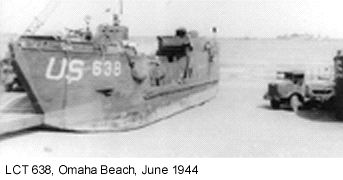
At 1300 hours we are ordered to beach again and since the Beach master
advises that he has no Army personnel to unload our cargo we start unloading
it ourselves and stacking it on the beach above the high tide per
instructions of the Beach master. The beach is still littered with bodies
and gear and debris of war but the Army now has a burial detail wrapping
bodies in canvas bags and burying them temporarily on the beach.
We had unloaded about half of our cargo when the tide came in around
midnight and allowed us to retract from the beach for the night. On the next
high tide around noon the next day we beached again and unloaded the
remaining cargo stacking it on the beach as before.
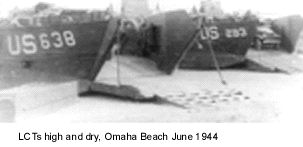
From June 8 until June 19th we ran ship to shore loads from
large vessels standing offshore. We carried vehicles, personnel, equipment
and ammunition. We estimated that we put 1200 tons of ammunition on the
beach and believe we were designated an ammunition carrier, possibly because
of Skipper Grahams civilian experience with the manufacture of high
explosives.
On June 19 the weather really deteriorated and developed into a major
storm. The blockship breakwater had been almost completed for the protection
of small vessels such as ours but there was insufficient room for all the
small craft to shelter in this area and on June 20 we were anchored just on
the edge of it when a British LCT came too close and damaged our anchor
cable pretty badly with its screws. The anchor cable finally parted and we
stayed underway until the high tide started to recede and we then beached on
a stretch where no other vessels had beached.
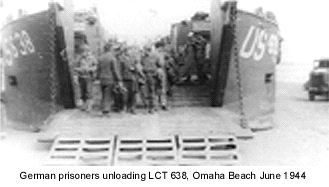
At low tide we found our anchor well out on the sand flats and with the
aid of an Army bulldozer we brought it back to a point where we would have
dropped it on a normal landing and we spliced the cable to it so that it
would help us pull off the beach when the tide came back in. When the tide
did come in and we refloated we attempted to retract with full back down
power and winching the anchor but the surf was so high that the anchor just
pulled in to the ship and the engines were insufficient to retract against
the heavy surf. Many other vessels were washed ashore with the high tide and
all were bashing and mangling each other in the heavy surf. This kind of
jolting and jarring had many seasick who had never been seasick before. Soon
we were out of food, living on C-rations and hording what little fresh water
we had.
On June 23 the storm subsided and we inspected the ship for damage. There
are great holes in both port and starboard sides, both sides of the bow are
caved in and the starboard corner of the stern is badly mangled. Every
watertight compartment on the starboard side has a hole in it. The bulkhead
in the head, galley and crews quarters is stoved in and two of the three
Diesel engines have sand in the cooling systems. We try running one of the
generators on bilge water so we can cook but the galley is so badly damaged
that the stove does not work. Lt. Cmdr. Pruit and Lt. Johnson inspect the
ship but no decision is made as to what will be done. We built a bonfire on
the beach and did some cooking on that and on June 24 the Motor Mechanics
and Electrician got the stove repaired and we ran one of the generators on
bilge water long enough to prepare meals. The LCT 640 had come on the beach
alongside us during the storm and they were in worse shape than we were so
they used our galley to prepare their meals.
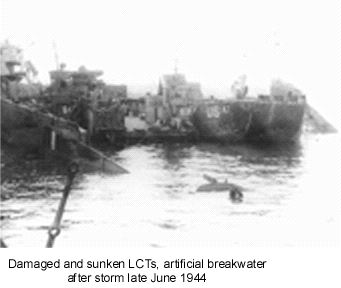
On June 26 we drew some food and toilet supplies from an LST that beached
with a load of Army personnel. The Army loaned us a jeep to carry these
supplies. On July 1 a Lt (jg) from NOIC came aboard with orders to bivouac
the crew at the CB Camp on the beach and that failure to do so would result
in arrest. So we all took billets there but a watch had to be maintained on
the ship so there was always someone aboard in shifts (watches).
On the afternoon of July 5 we were advised that we would be pulled off
the beach along with the LCT 640 so we made fast the lines holding the two
ships together. We had enough undamaged voids on both ships that we had no
doubt that we would float. A U.S. Navy tug (an ART) pulled both ships off
with one big heave at high tide and towed us out near the artificial
breakwater and we anchored with our anchor holding both ships since the LCT
640 had lost their anchor. On the 7th we were towed to the block
ships and tied to them as we were interfering with salvage work where we had
anchored.
On July 8 a tug brought two heavily damaged Mark 5 LCTS and tied them
alongside. They had no personnel aboard and during the night one of them
sunk. Also, that night a buzz bomb hit somewhere in our vicinity but we
never heard whether it did any damage.
On July 11 we received orders by radio that we were to be towed back to
England and at 0845 two LCMS came alongside and towed just the 638 (not the
640) to the outer harbor alongside the LST 58 which was to tow us back to
England. We had just a part of the crew aboard who had been standing watch
at the time of being towed off the beach and to keep risking anymore lives
in case of trouble the Skipper asked for two volunteers to stay aboard
during the channel crossing. Volunteers were John Mikash and J. C. Brumley.
The rest of the personnel were placed aboard the towing LST.
At 1200 hours we were rigged for towing and by 1800 hours the convoy was
forming and our towing LST was in the port lead as Convoy Commodore of a two
column convoy of 8 or 10 ships. We find that the towing cable is frayed but
the Commodore will not hold off long enough for us to make repairs but did
allow us to get an emergency cable secured and we were underway. We had no
orders and no knowledge of what port we were being towed to.
At 2000 hours the towing bridle broke and the emergency cable snapped
like a piece of thread. We were swung out into the middle of the convoy and
fearing being rammed by one of the other ships we started the engines (full
of sand or not) and by running them at full speed with Brumley at the helm
and Mikash on the engines we were able to pull out between the two columns
of ships and avoided any collision. We were unable to keep up with the
convoy and they kept right on going and were soon out of sight.
As soon as we saw that we were clear of the convoy we throttled down the
engines to cruising speed and continued towards the British Coast as best we
could. The sea was running high and we would heave and yaw so that there was
no way we could steer a straight coarse. We had a very bad list to starboard
because of the number of punctured voids and with just three people aboard
there was no way we could have manned pumps and kept going at the same time.
So we never felt very secure.
Sometime around midnight we saw a light approaching at a fairly high rate
of speed and had no idea whether it was Allied or German so we just kept
going. The ship proved to be an English Escort vessel and they maneuvered in
close enough so that we could use "loudhalers" (amplifiers) to
converse and they asked if we needed assistance and we told them the
condition of our vessel and its engines. They radioed a British Corvette
(the K-142) which was somewhere in the vicinity to see what they could do
for us. The Corvette arrived about one half hour later and said they would
take us in tow.
Getting a line across from the Corvette to us in that heavy sea was no
small feat. Mikash and Brumley did their own thing trying to maneuver as
close to the Corvette as possible and the Skipper up on the bow caught the
small line that the Corvette shot over and it took all three aboard to haul
the 4" diameter hawser that had to be pulled from the corvette to our
LCT.
We learned a good lesson in seamanship from the British because they
towed us all the way into Portland Harbor with no breaks. The hawser would
go taut and then slack with the swells like a rubber band.
On July 7 after the Corvette towed us into Portland Harbor and cast us
adrift Mikash and Brumley maneuvered the ship to a harbor buoy alongside the
LCT 211 (which was also in for repairs) and the Skipper handled the lines
for mooring. Mikash and Brumley were just great at maneuvering the ship
alone. No one stood on any ceremony. We just did what had to be done. The
members of the crew who had been aboard the LST 58 returned to the ship
later in the day and on July 18 those members who had been assigned to the
CB Camp returned to the ship. They had come over on an LSD (Landing Ship
Drydock) which had brought the LCT 640 over inside its drydocking facility.
On July 19 the US Navy Tugboat 638 towed the LCT 638 and the LCT 210 to
Dartmouth and then on to Plymouth on the July 20. We moored at Commercial
Wharf there at the Hoe where we stayed until August 6. On that date two LCMs
came alongside and towed us to the drydock and the ship was slowly pulled up
out of the water on rails and repairs were started. The crew were given 8
day leaves to London half the crew leaving in the first 8 days and the other
half during the 2nd 8 days. Ensign Schwartz was transferred to
the base in Plymouth leaving Ens.
Repairs were completed on August 25 and the ship was moved to the graving
dock where topside painting and minor repairs were completed. On August 30 we
moved to the Royal William Victualating Yard for deperming and on the August
31 to C buoy in Plymouth Sound for Ranging and the finding is that the
deperming was not done properly so on September 3 we go back Royal William
again for another deperming and on September 5 through the degaussing Range
again and find that the compass checks out OK. Then to Turnchapel Hard to take
on fuel and water and several Army trucks to be ferried to Cherbourg , France.
On September 6 we set sail for Cherbourg with Sub Chaser 1291 as escort
vessel and guide and entered Cherbourg Harbor about 1400 hours on September 7.
We beached at one of the hards and unloaded the trucks around 1900 and tied to
a buoy in Petite Rade for the night. We left Cherbourg at 1100 hours on
September 8 and arrived at Omaha Beach at 1630 reporting to the LCI 83 for
further orders. From then until November 8 we unloaded everything imaginable
from the steady stream of supply ships that shuttled from the UK and the USA.
We landed troops (500 to 600 at a time), trailers, trucks, crated machinery,
crated weapons, ammunition, weapons carriers, tanks, jeeps, barbed wire.
camouflage nets, liquor, cigarettes, typewriters, engineering supplies, spare
parts, steel pipe, hospital supplies and food.
On September 24 Ens. Charles E. Lilly reported aboard as Relief Officer.
On October 3 another huge storm stopped beach unloading and we laid to
inside the artificial breakwater until the storm subsided and on October 7 we
were ordered to Isigny. As we were leaving the breakwater we were stripped of
our bow ramp as we encountered a huge wave and we returned to the breakwater.
On October 8 we were used as a tug to pull the LCTs 540 and 648 off the beach
and on October 15 we beached and had a new ramp installed. On October 17 our
mast was torn off coming alongside the LSI Monoway.
When all operations ceased on Omaha Beach (November 8) we had a seized port
engine, five punctured voids (from hitting wrecks which were everywhere and
unmarked), no ramp hooks to keep the ramp from breaking loose in a heavy sea
(as before), no hot water facilities and the Officers Quarters were leaking in
a heavy sea. On November 15 we beached and replaced the seized engine with a
new one and set sail for the UK in a convoy of LCTs. Had water in the fuel
problems and had difficulty keeping up with the convoy. Seas were rough and we
pulled into the Isle of Wight for the night and on into Portland Harbor next
day. On the 17th proceeded to Salcomb, England which is to be our
base and we start cleaning the ship and repainting above the waterline.
On November 30 Ens. Graham was relieved as O-in-C with orders to return to
the States and Ensign C. E. Lilly was assigned O-in-C of the 638.
In early December 1945 LCT Flotilla 19 moved to Plymouth where repairs were
made and where most were loaded on the decks of LSTs or Liberty Ships and
returned to the States. LCT Flotilla 19 was disbanded at the end of December
but the 638 was sent back to the French Coast in late December where it
continued to unload units of Gen. Pattons Army and practiced bridging the
Rhine River with LCTs unloading from the bow of one LCT to the rear of
another. They never were actually used for this purpose and the 638 was
returned to Plymouth, England in late February.
In March the 638 was dismantled into three sections and loaded aboard a
Liberty ship with Gus Wyatt the only accompanying crew member. During the
voyage the center section broke loose from its moorings on the deck of the
Liberty Ship in foul weather and was moving back and forth creating a hazard
to the ship and all aboard and it was decided to tilt and let it slide
overboard into the ocean where it was sunk by shelling with the Liberty Ships
5 inch guns.
It can only be assumed that the remaining two sections were scrapped upon
reaching the United States.
By: Joseph D. Graham
In a letter from Mr. Graham, he states that he found a photo
of LCT 638 on the NavSource
web site showing it beached on the Hungnam waterfront Korea, during the
December 1950 evacuation. I also came across information from Jane's Fighting Ships 1970-1971 &
1972-1973 that she was in a group of LCU's 638,700, 779,1174,1225,1271, 1278 that where
not stricken until 1958.
The 638's sister ship the 637 was known to have been in danang in
1967 during the Vietnam war as YFU 55 and as late as March 2000 she was said
to now being used as a cargo boat in the Caribbean.
